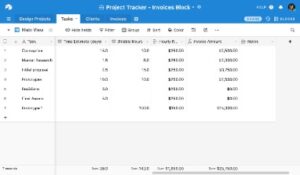Content

Rakesh Patel is the founder and CEO of Upper Route Planner, a route planning and optimization software. With 28+ years of experience in the technology industry, Rakesh is a subject matter expert in building simple solutions for day-to-day problems. He loves sharing his thoughts on eliminating delivery management challenges via blogs. Other than being aware of the amount of stock that you need to keep to satisfy demands, calculating EOQ has some other lesser-known benefits.
The EOQ formula determines how much stock you should keep on hand to run your business most efficiently with better inventory ordering methods. EOQ aims to minimize the total cost, order costs, and carry costs of inventory. It allows for the calculation of the exact time frame for carrying inventory to minimize all costs. To minimize order costs or carrying costs and maximize the rate of inventory turnover. Though as previously stated, the formula does not account for variable cost or demand, leading you to recalculate EOQ. This is why businesses often buy more stock than suggested by their EOQ number to not run out of stock during higher demand periods.
Possibility of running out of stock
Economic order quantity is a company’s ideal order quantity size. This figure helps minimise overordering, overspending, and storage costs. The ideal inventory should fulfil the demand, thus maximising revenue while not tying excessive working capital in stocks. On the other hand, carrying costs, which are variable or semi-variable in nature, tend to change nearly in direct proportion to the level of stock carried in a manufacturing firm. These tools can help them optimize inventory management and facilitate their growth. Critics have argued that the assumptions of constant demand and fixed cost levels are a limitation of the EOQ model.
- Even if you have low-demand deliveries it sure would be helpful to make it as efficient as possible.
- Inventory costs can also go up depending on how you order, what gets damaged, and what products never sell.
- Annual demand is the number of products you expect to sell per year according to sales forecasts.
- This formula aims at striking a balance between the amount you sell and the amount you spend to manage your inventory.
- Another important extension of the EOQ model is to consider items with imperfect quality.
EOQ can help businesses avoid these costly mistakes by finding the perfect balance between meeting customer demand and minimizing costs. There are several key benefits of using EOQ to improve inventory management. The EOQ formula https://quick-bookkeeping.net/operating-profit-vs-net-income/ helps calculate the optimal order quantity to save money on logistics and ecommerce warehousing costs. By calculating EOQ, you’re able to make better decisions on how much product to order in a given period of time.
An example of Economic Order Quantity (EOQ) in Practice
Download the Wilson Formula Excel here, Test it first with a few products, the most important for your business. Then use it progressively with your entire items portfolio. In this example, we have a total of 1.7 hours to handle one order, which represents $42.5. You may add or remove processes depending on your specific business procedures.
- There is no generic number for the ideal EOQ number as it is simply a number that tells you the amount of annual quantity demanded of stock that you need to meet consumer demand.
- Which of the following best describes the objective of joint cost allocation?
- The total inventory cost is the ordering cost plus the carrying cost.
- Calculating economic order quantity requires high school-level algebra.
- This is why businesses often buy more stock than suggested by their EOQ number to not run out of stock during higher demand periods.
The carrying cost should be between 15-30% of the stock value. For a single order, the procurement cost is the total cost, which is obtained by adding up all the above costs and dividing the result by the number of orders placed during that period. The salaries of the personnel involved in all business processes are the main items to be considered when calculating the procurement cost. An ERP/MRP system also facilitates the use of many other supply chain management techniques that are not so dependent on consistent demand. Annual demand is the number of products you expect to sell per year according to sales forecasts. EOQ can only be used if customer demand is consistent, e.g. there are no seasonal fluctuations.
The Formula for Economic Order Quantity
It’s a great way to grasp how much product needs to be purchased to maintain an efficient ecommerce supply chain while keeping costs down. The Economic Order Quantity is a good tool to minimize total costs, as it is the theoretical optimal quantity to order in Inventory Management. We saw how to use the EOQ formula in Excel through various examples, and we deducted the corresponding frequency to order. Armed with EOQ, you can easily factor in additional information about supplier discounts or MOQs.
- Changes in demand or a desirable product modification will therefore cost you less.
- This team of experts helps Finance Strategists maintain the highest level of accuracy and professionalism possible.
- The XYZ Equipment Company estimates its carrying cost at 15% and its ordering cost at $9 per order.
- Once you have taken the time to calculate your EOQ, you can use Katana manufacturing ERP software toset reorder pointsandsafety stock levels to avoid production-stopping stockouts.
- However, even excess stock costs businesses when products get spoiled, become obsolete or do not sell.
- Some software products predict demand based on a product’s attributes instead of the product itself.
What makes the EOQ a compelling tool is that it is dynamic and can be revisited from time to time as your business grows. If there’s a change in any of your inventory costs, you can always tweak the formula and generate a new EOQ to suit the current conditions. This refers to all the costs that are involved in storing or handling the items in your store or warehouse. Economic Order Quantity Eoq The eoq formula must be modified in this scenario when there is a specific order cost. We must substitute “order cost” in the formula to accommodate for each specific cost. The total annual order cost divided by the unit production cost should still be a good indicator of how many units can be ordered during a year before incurring excessive costs.

